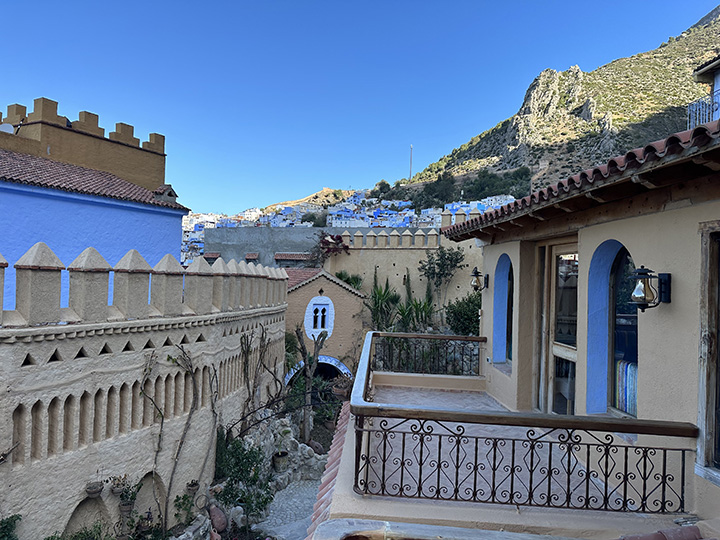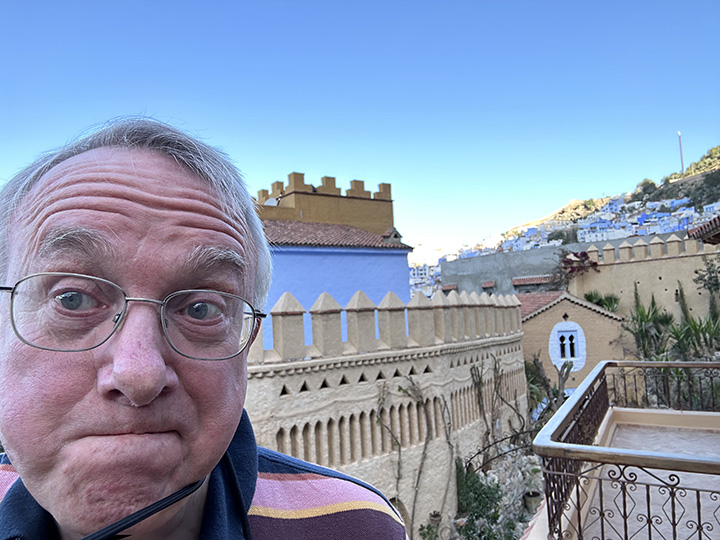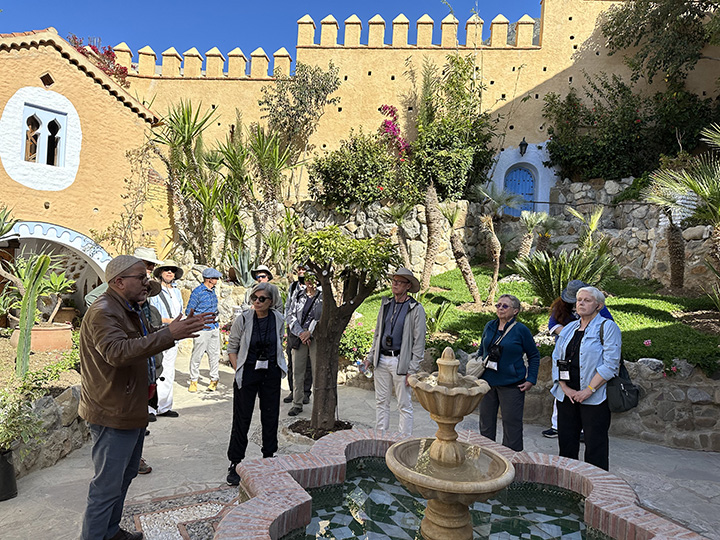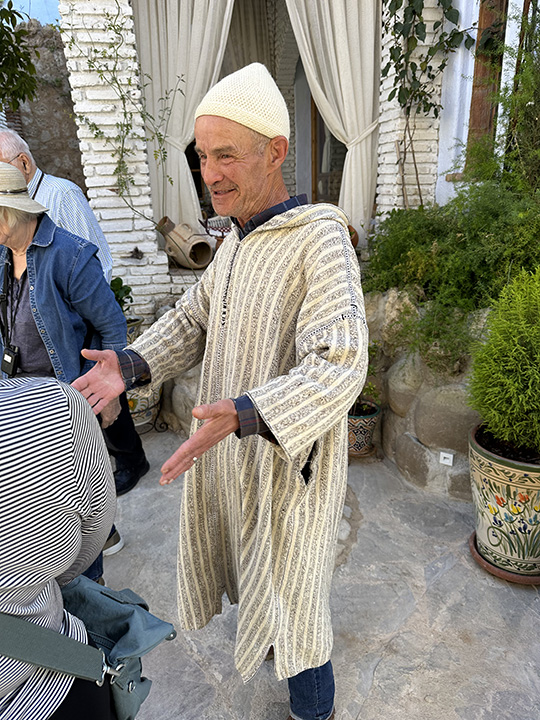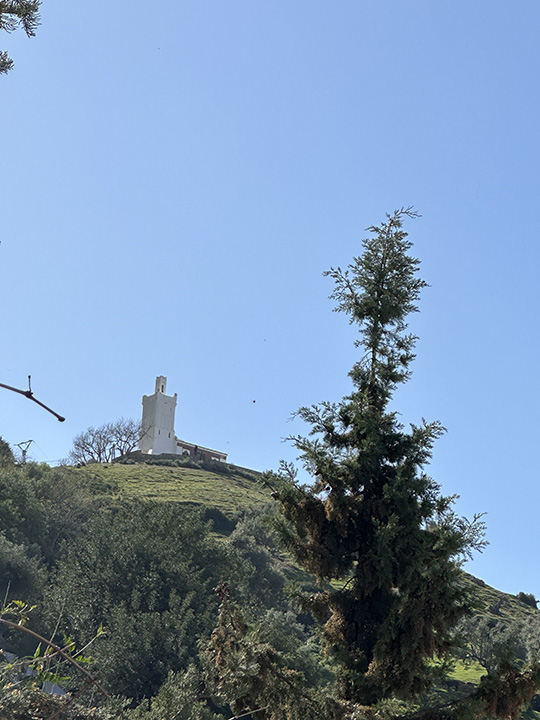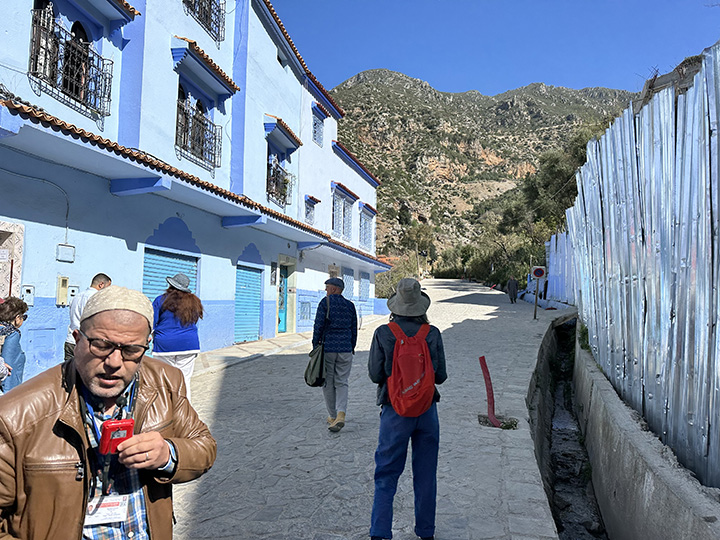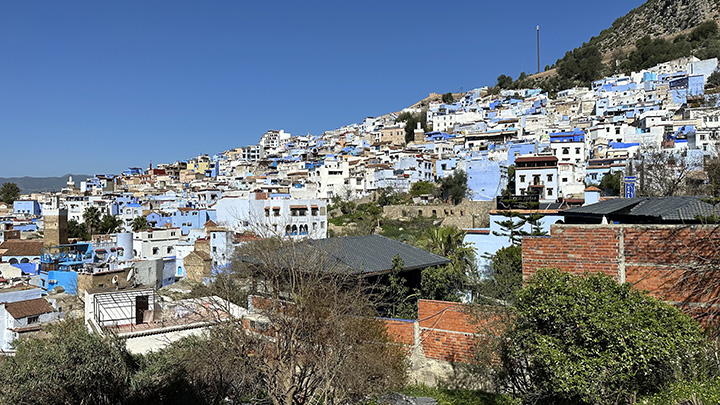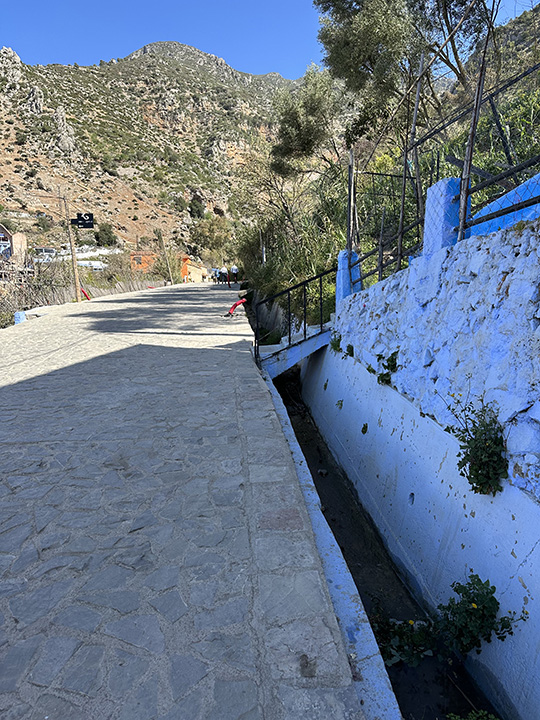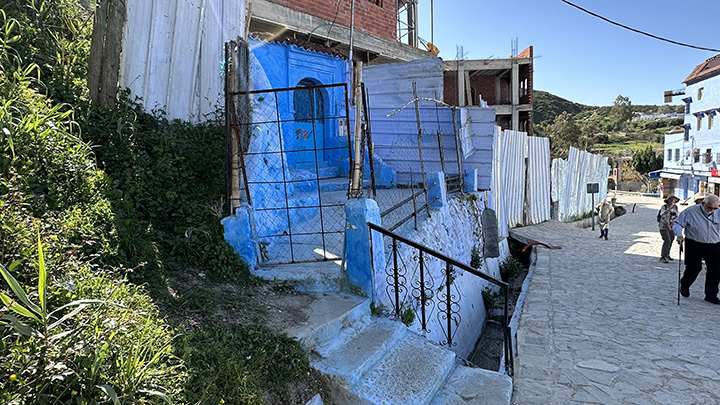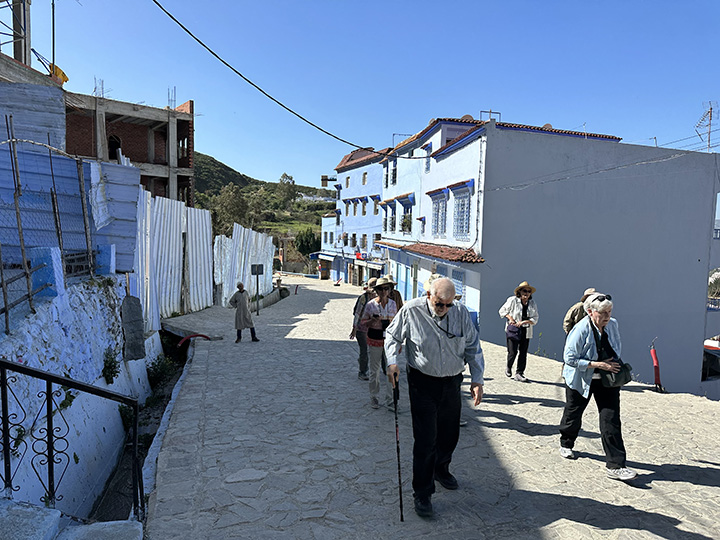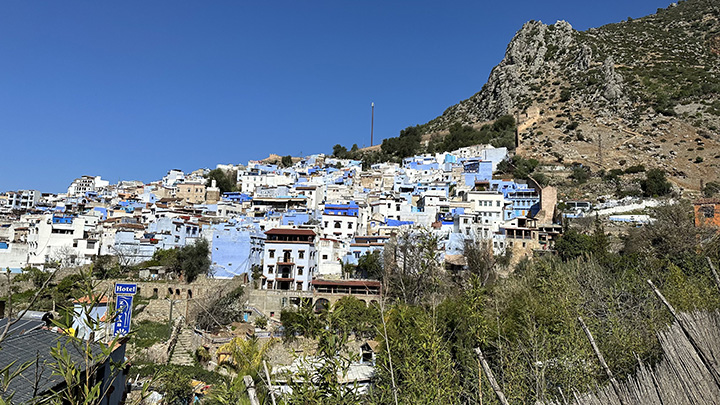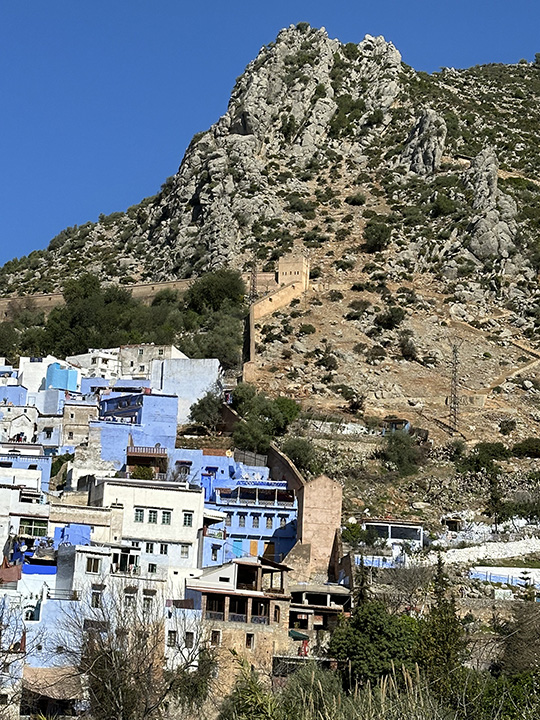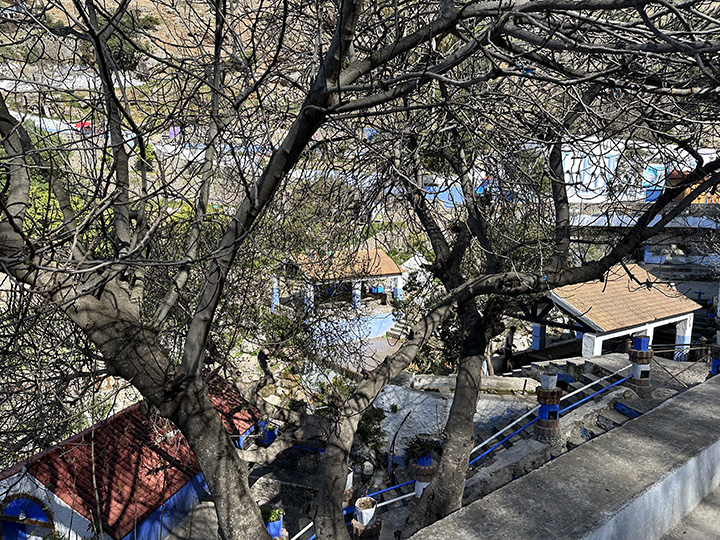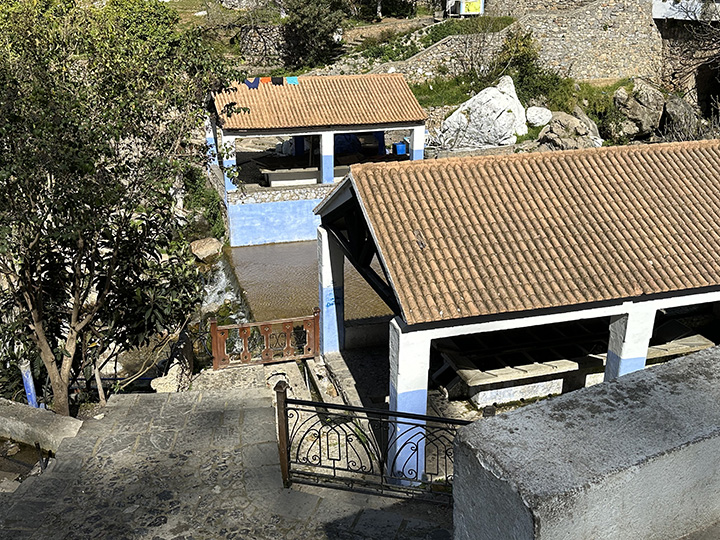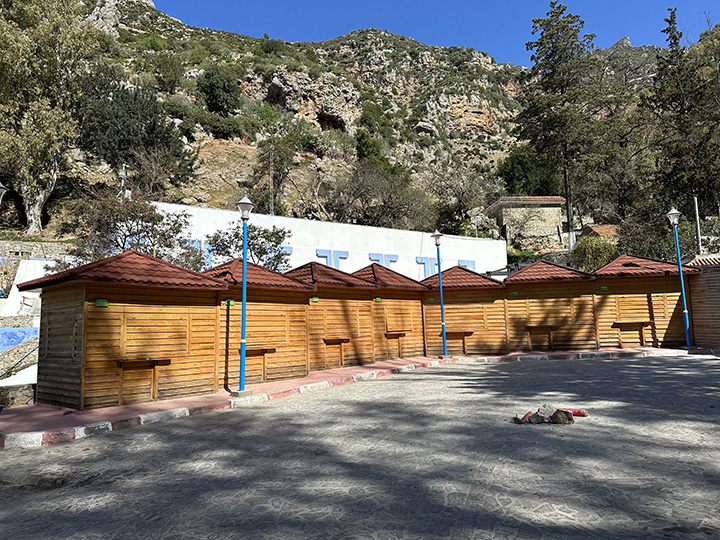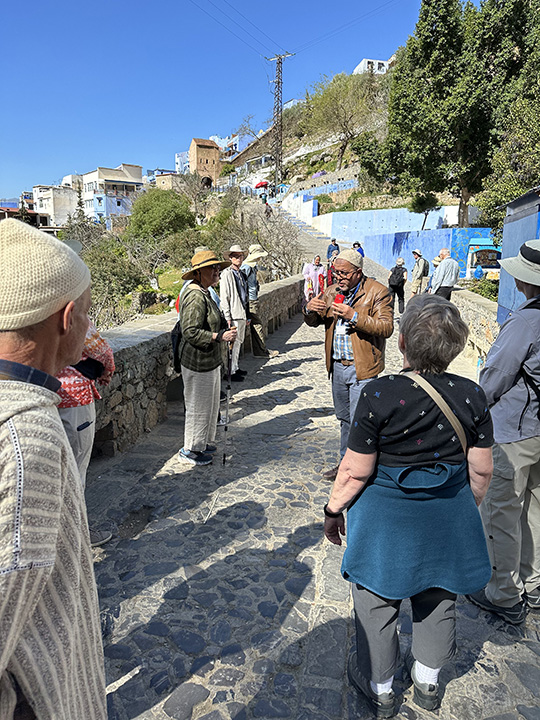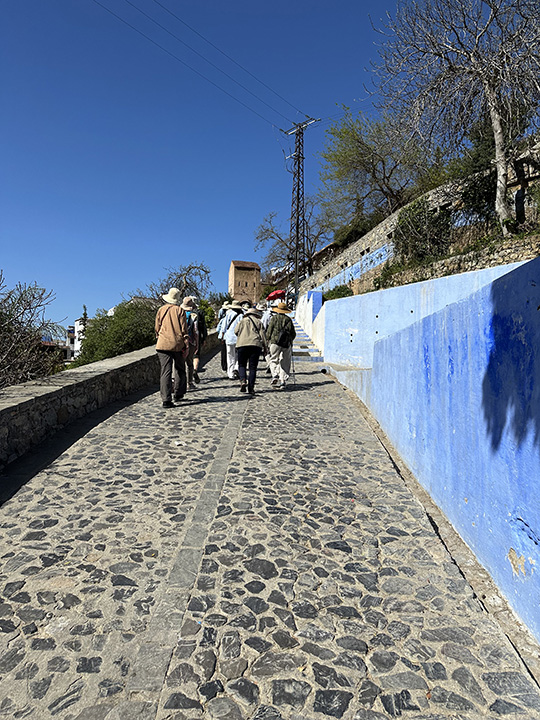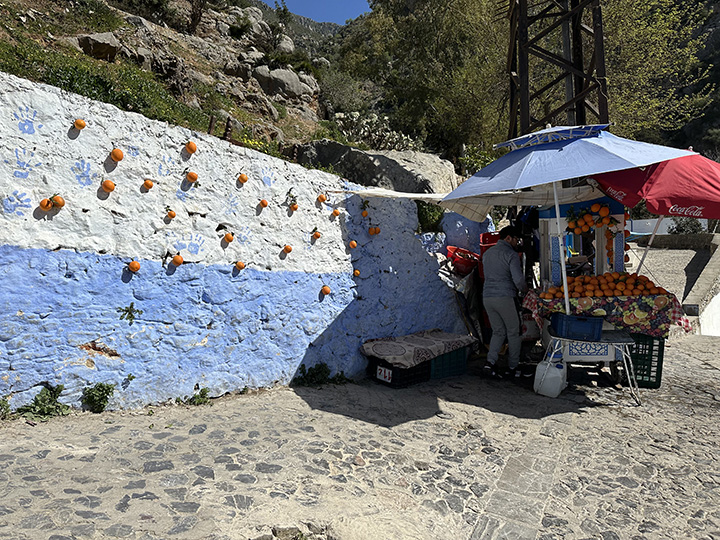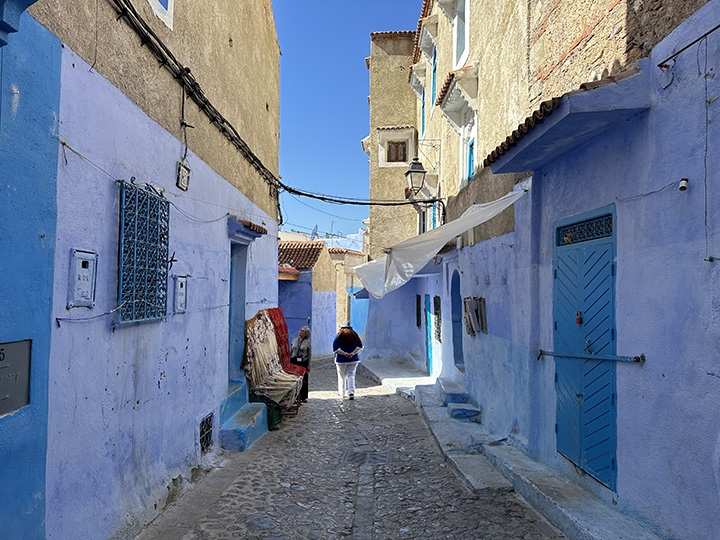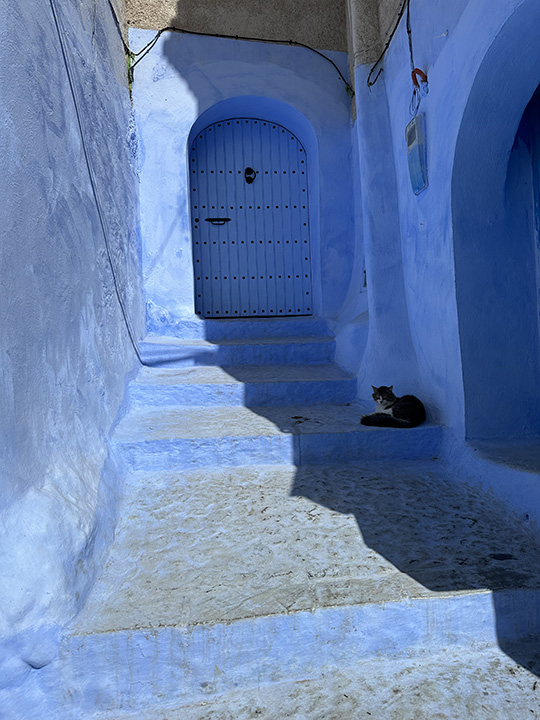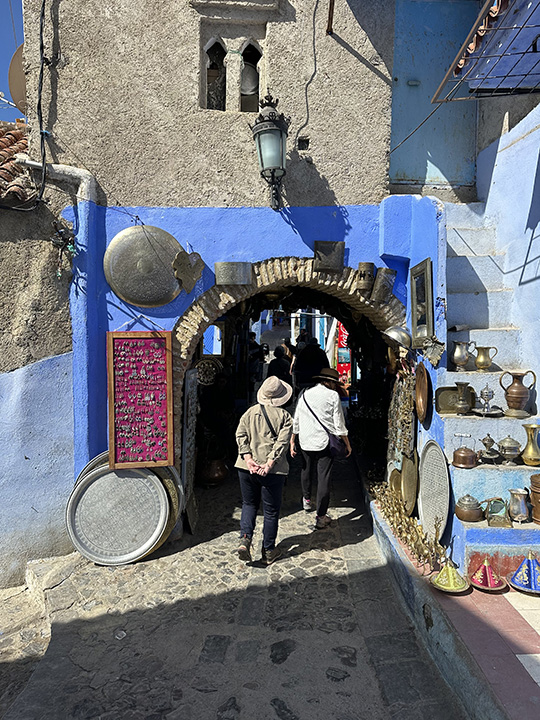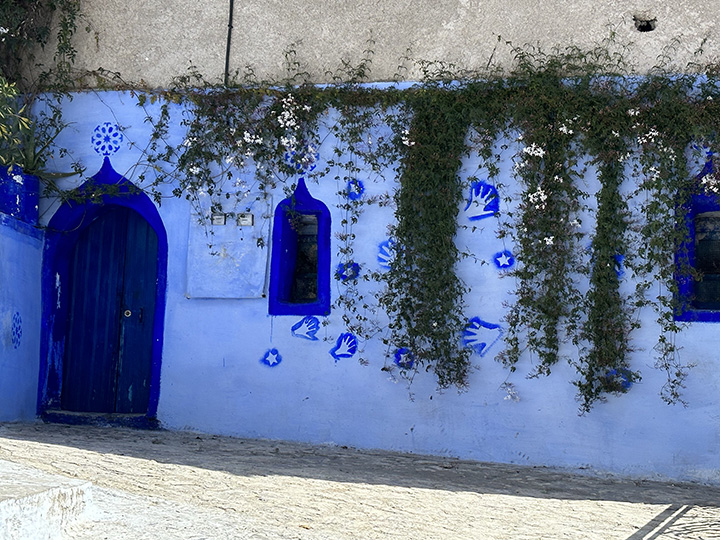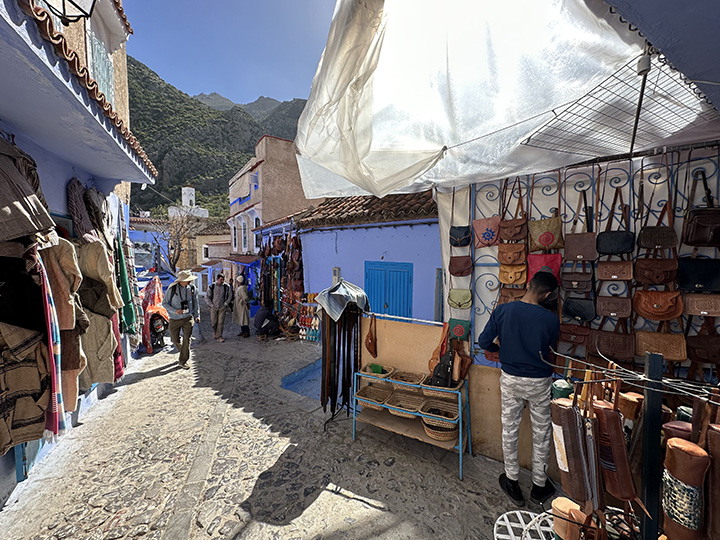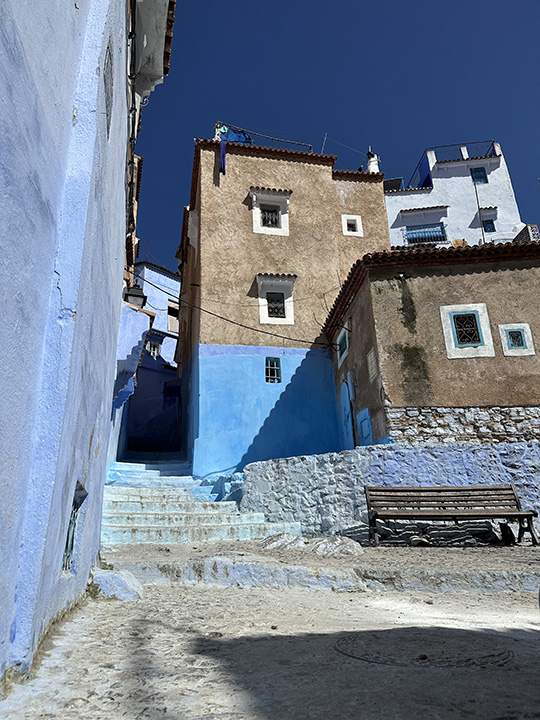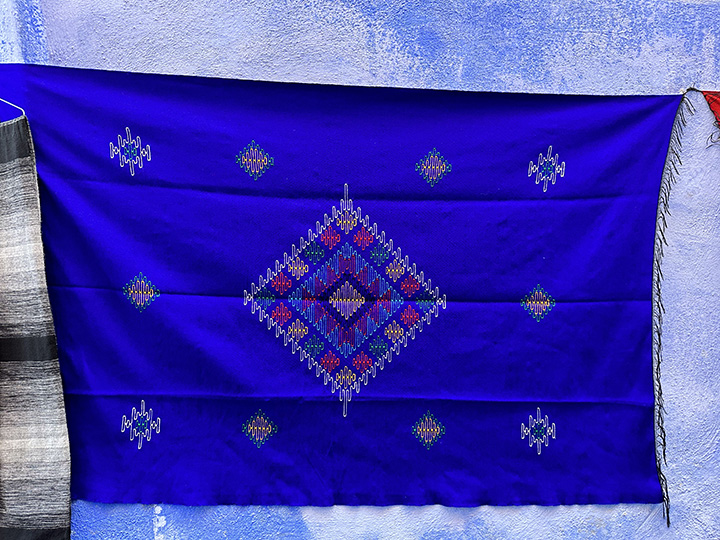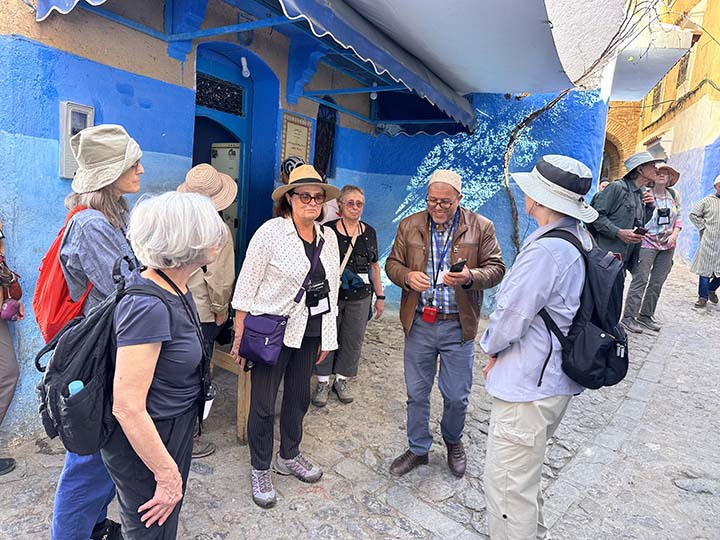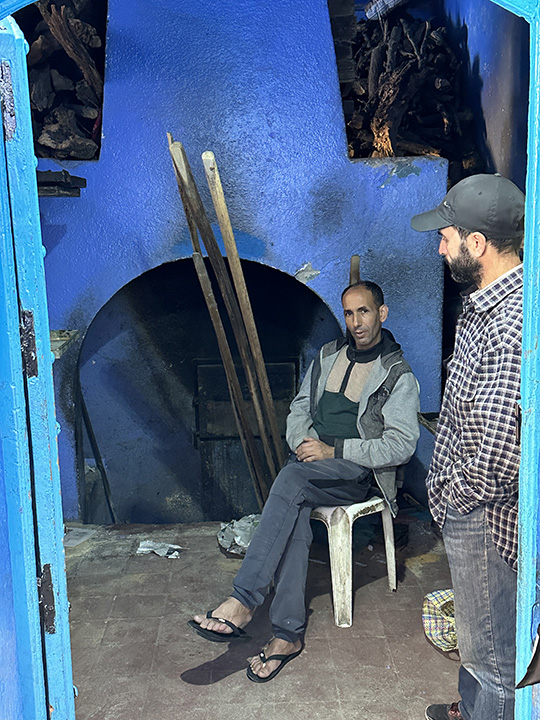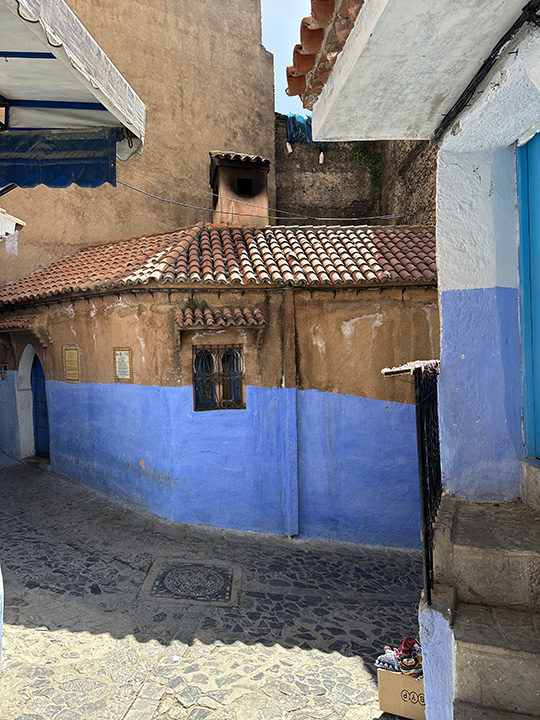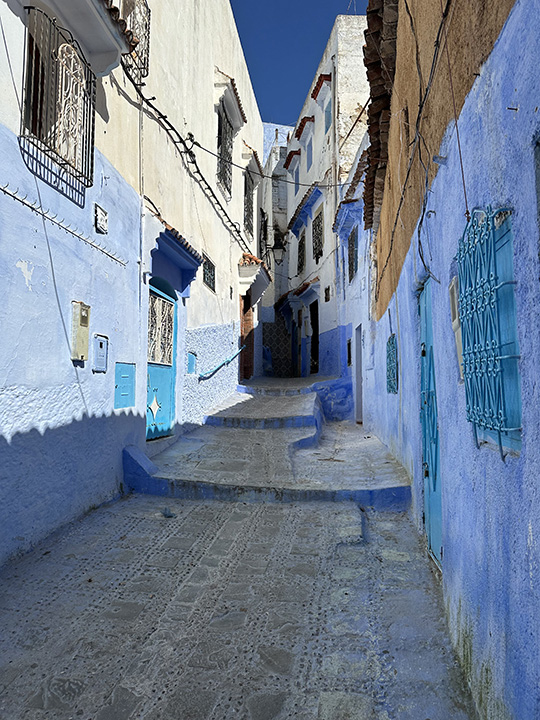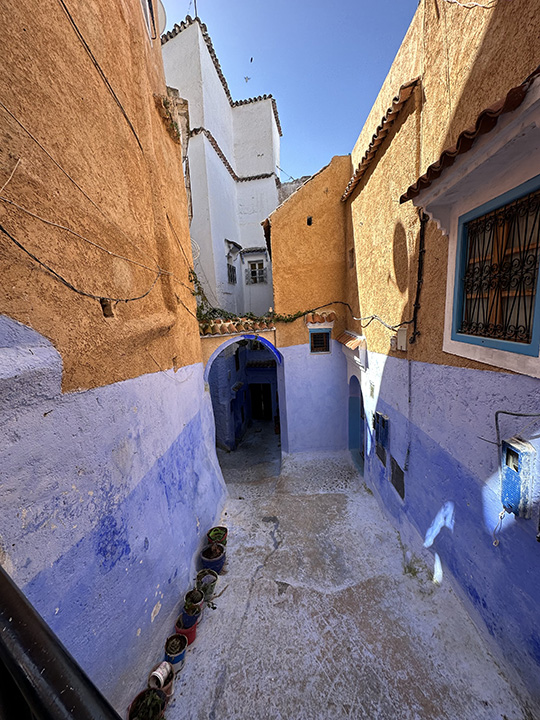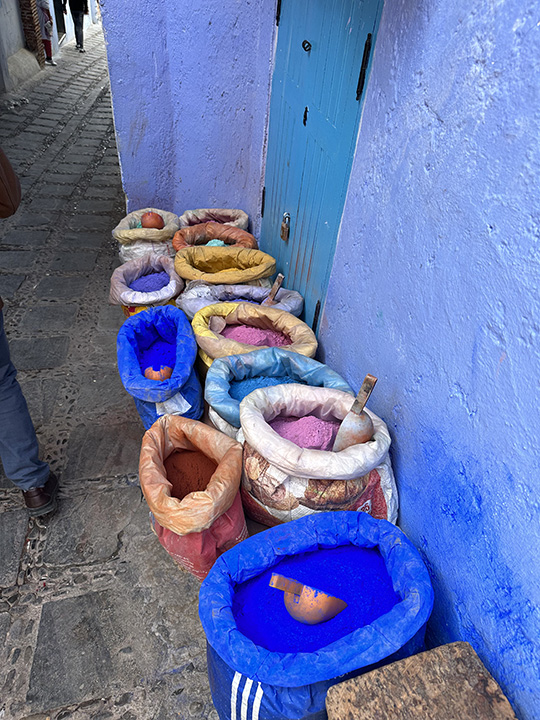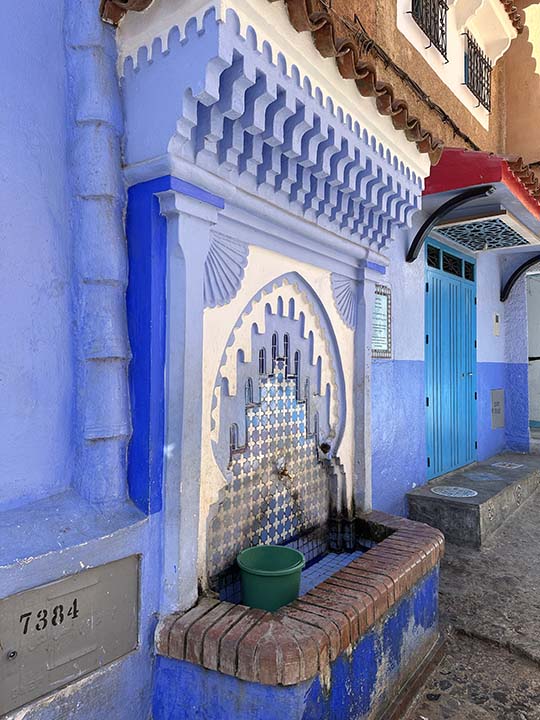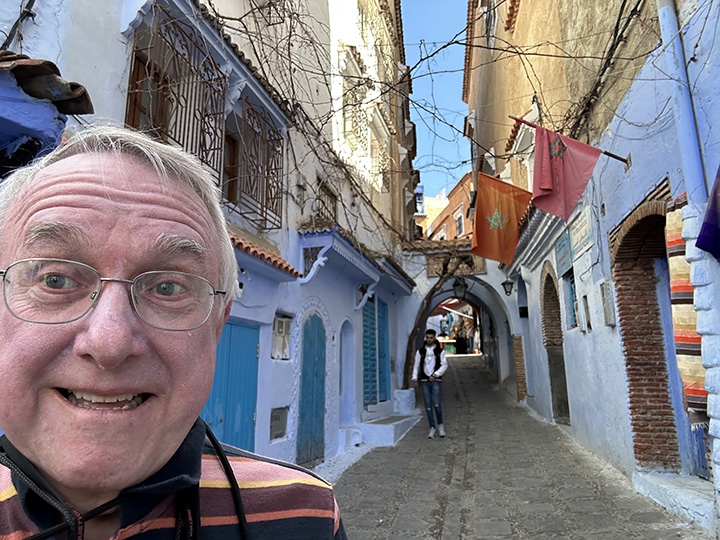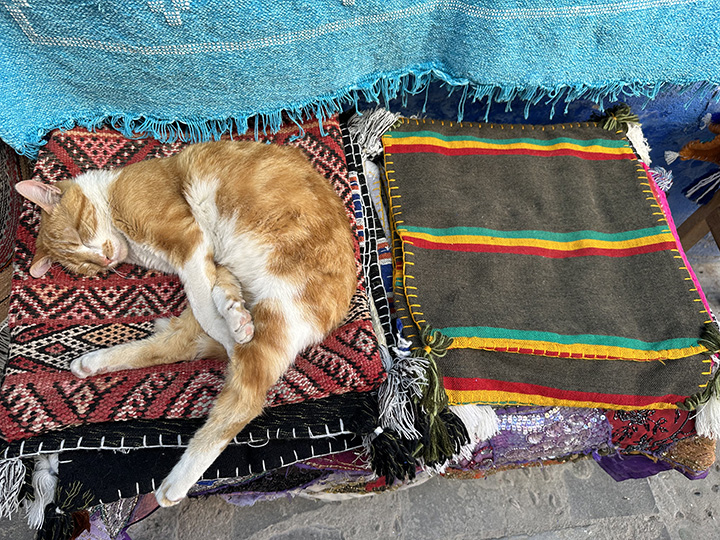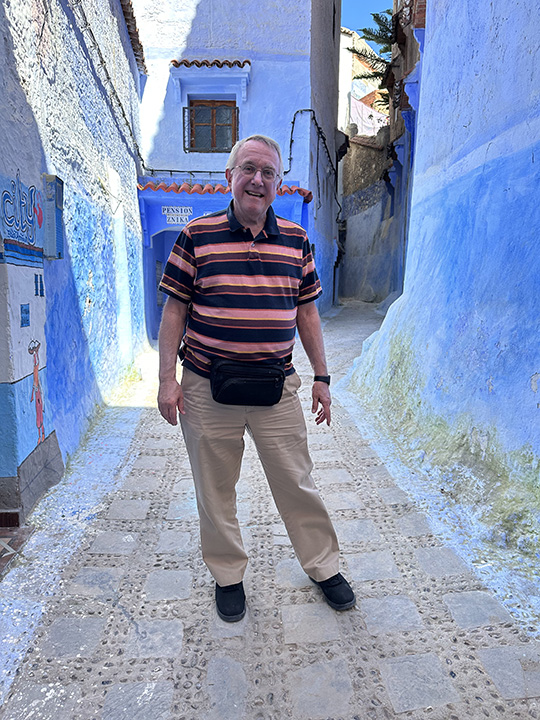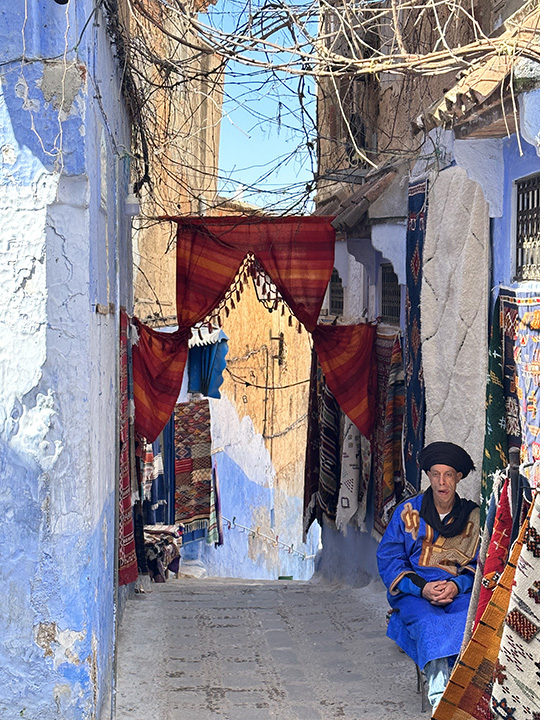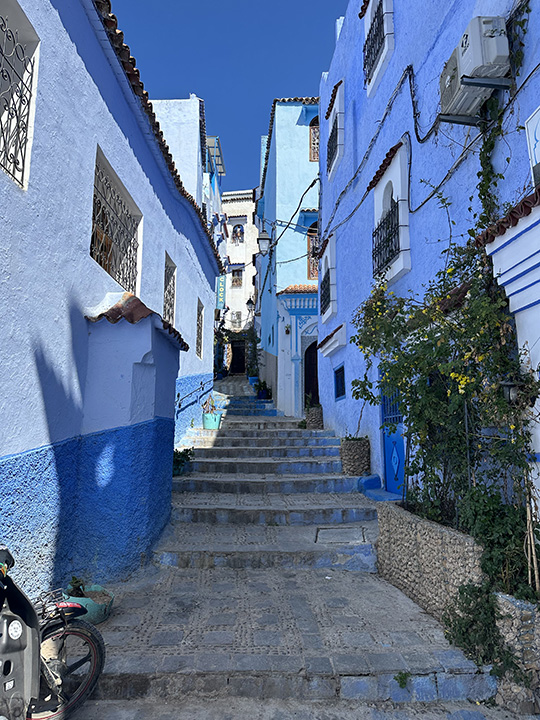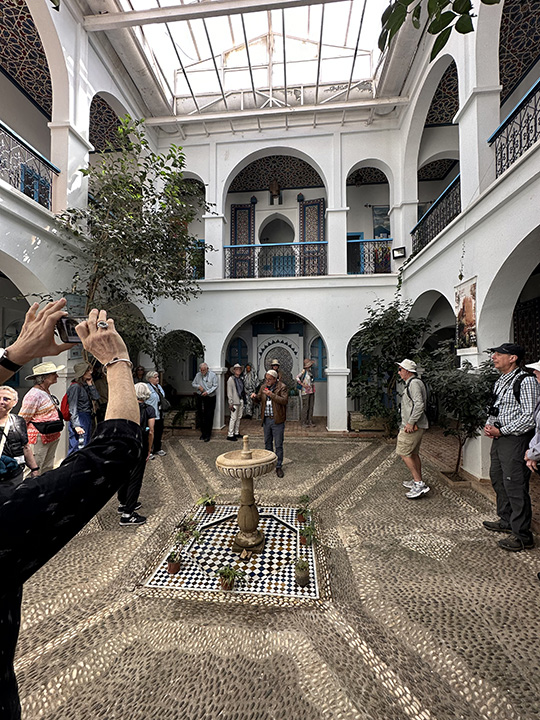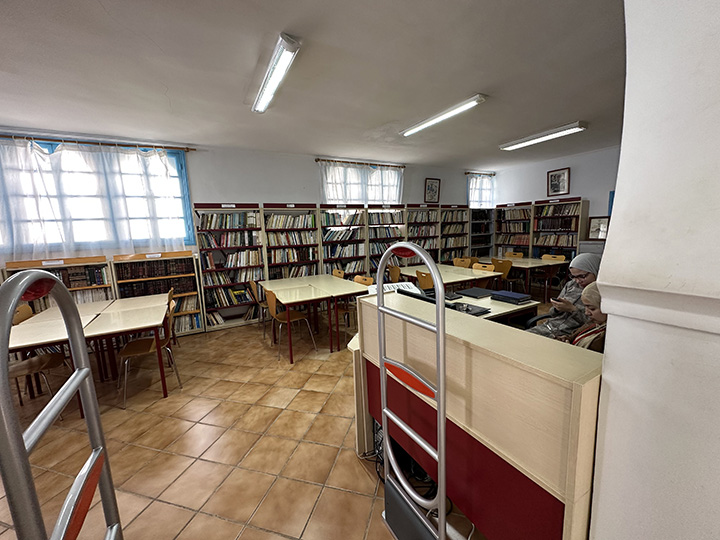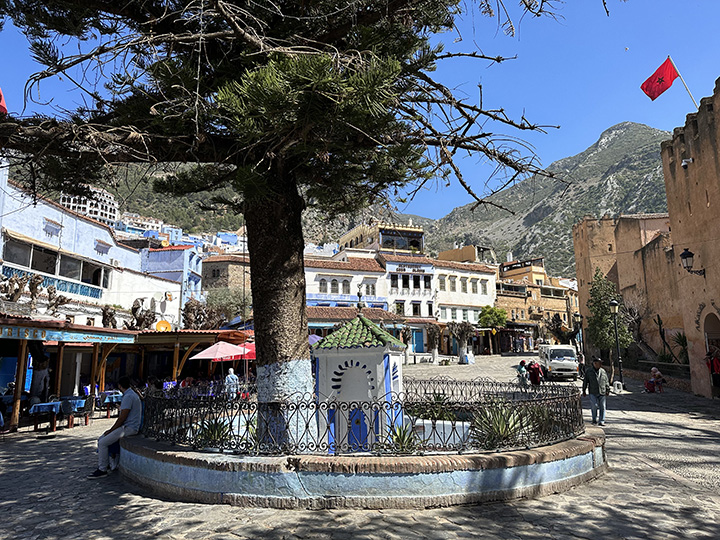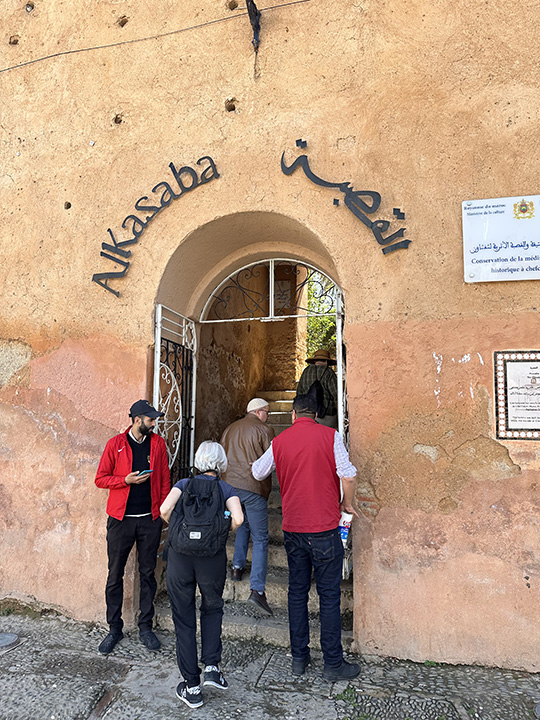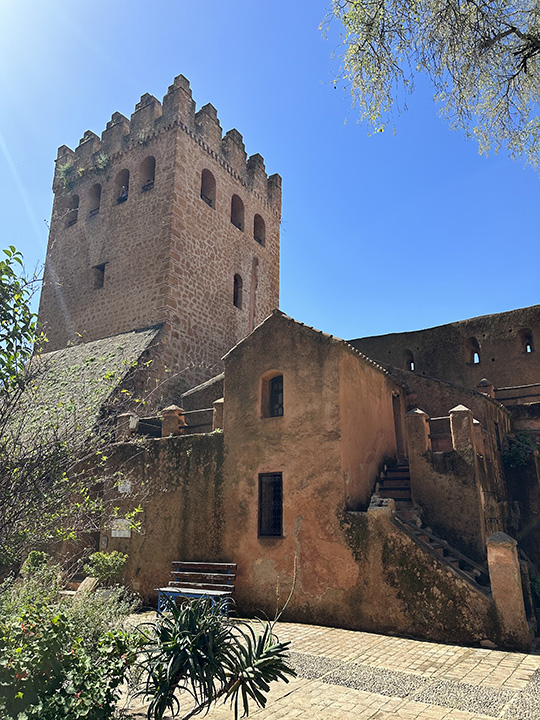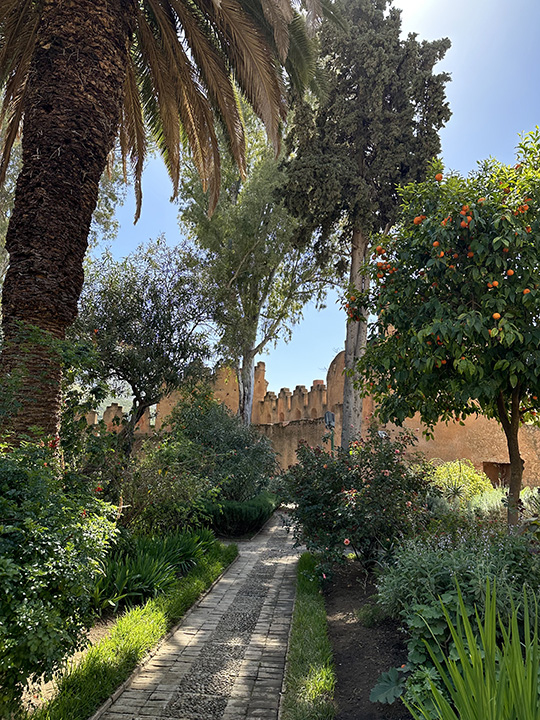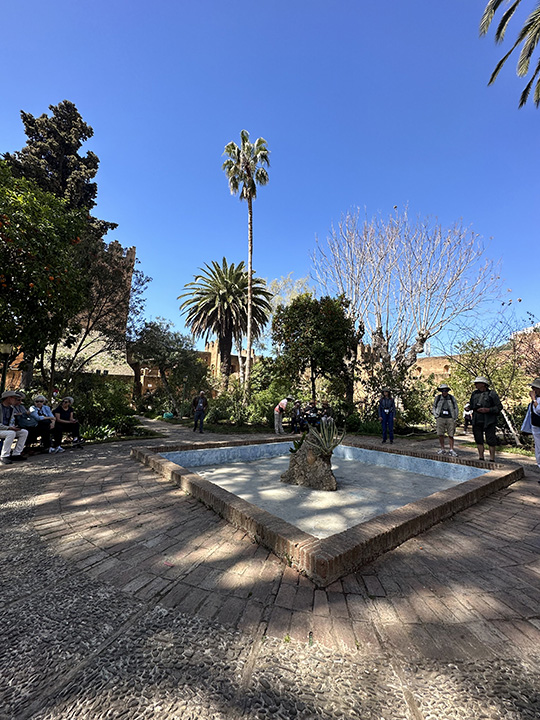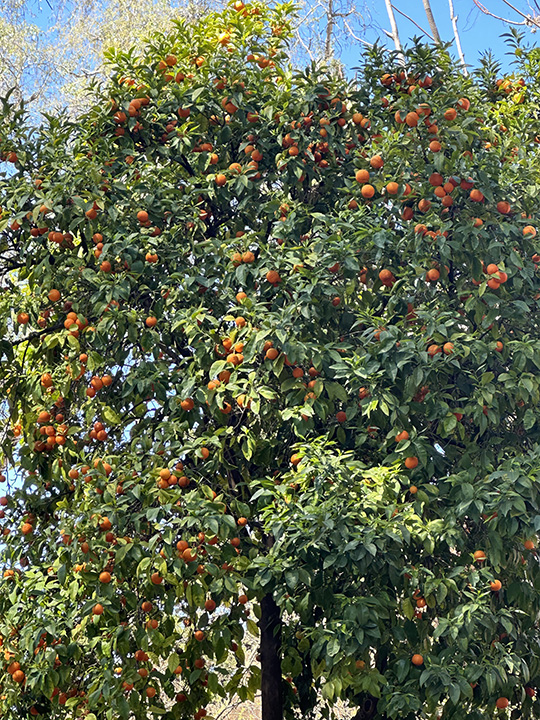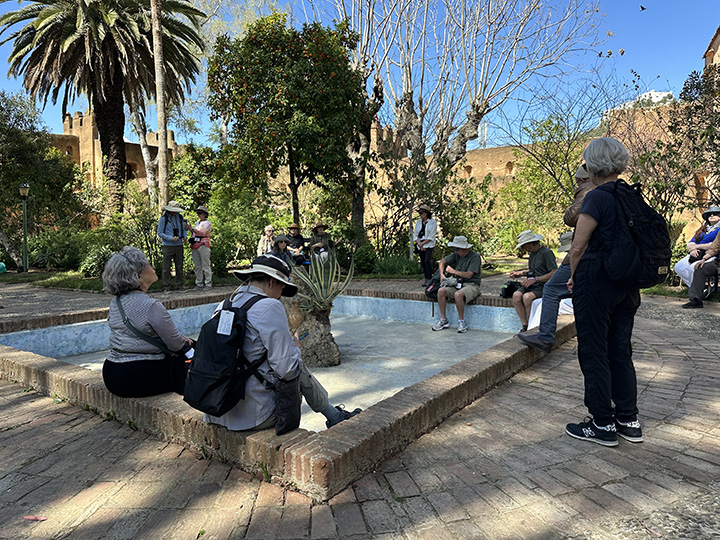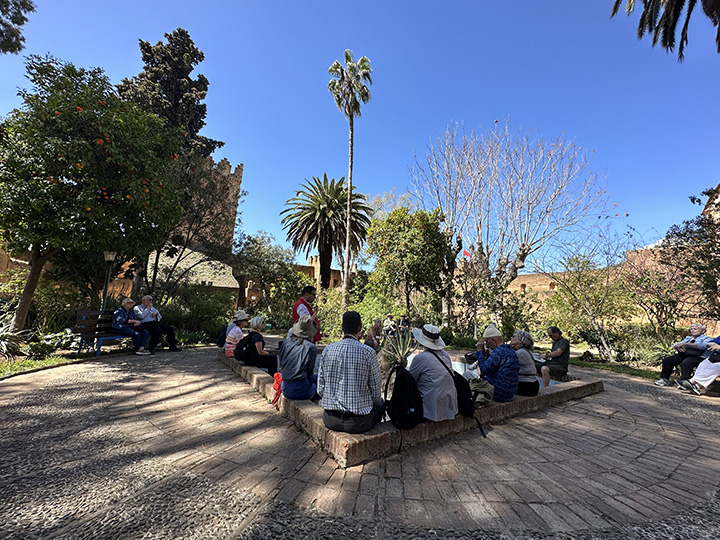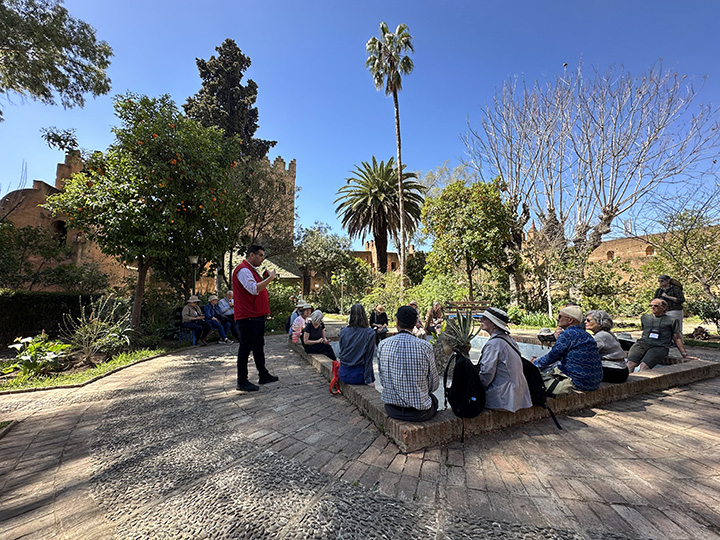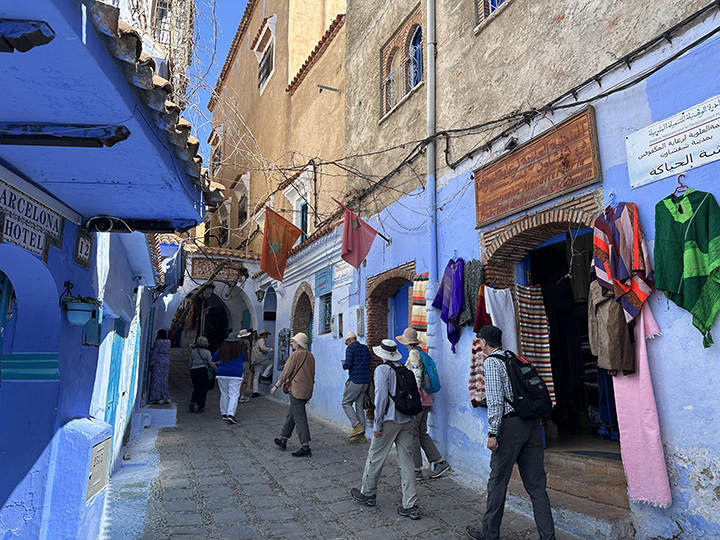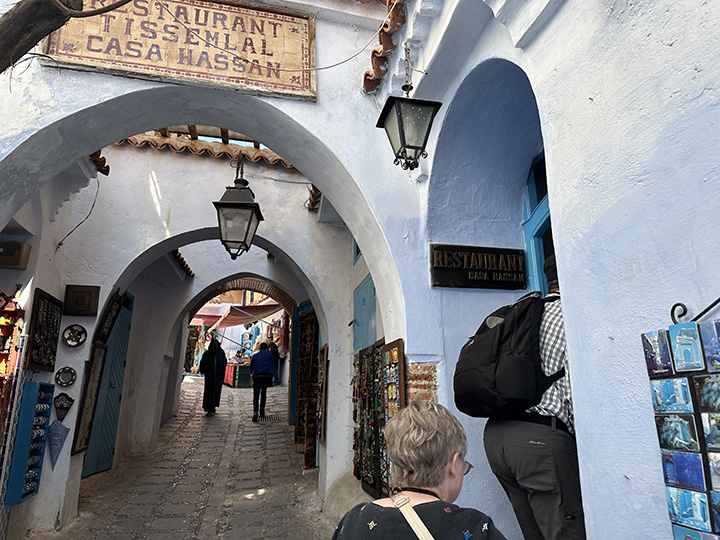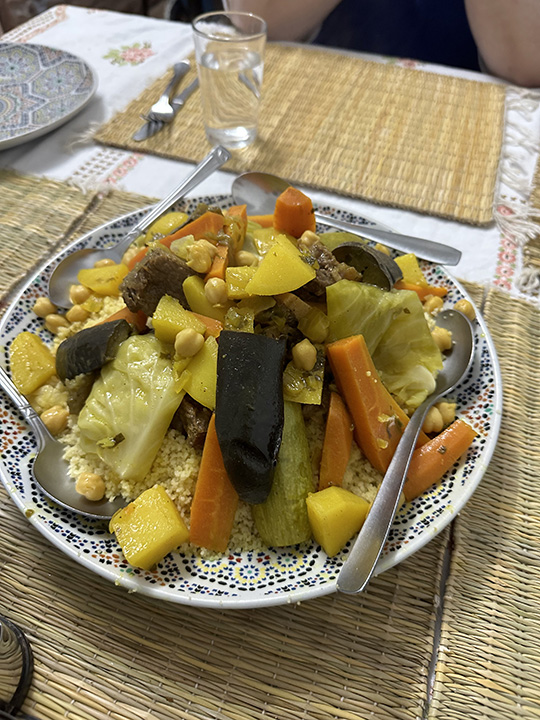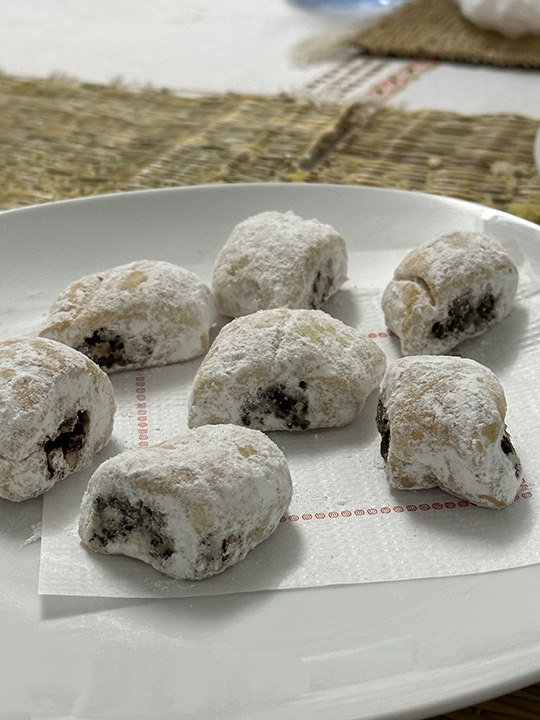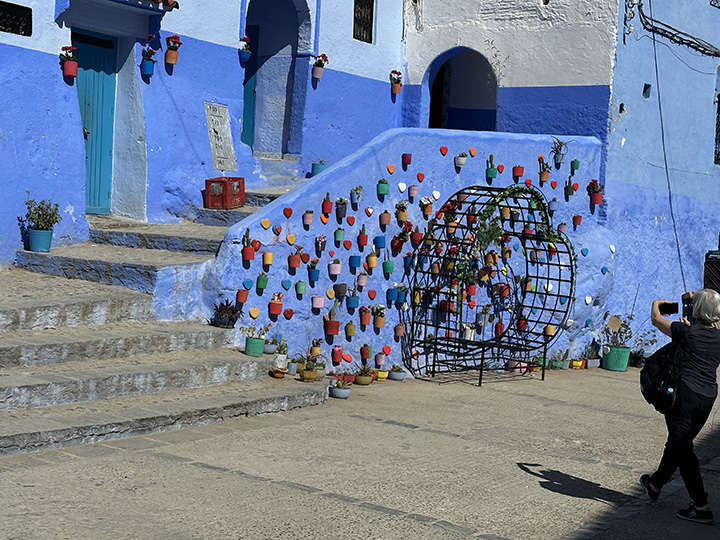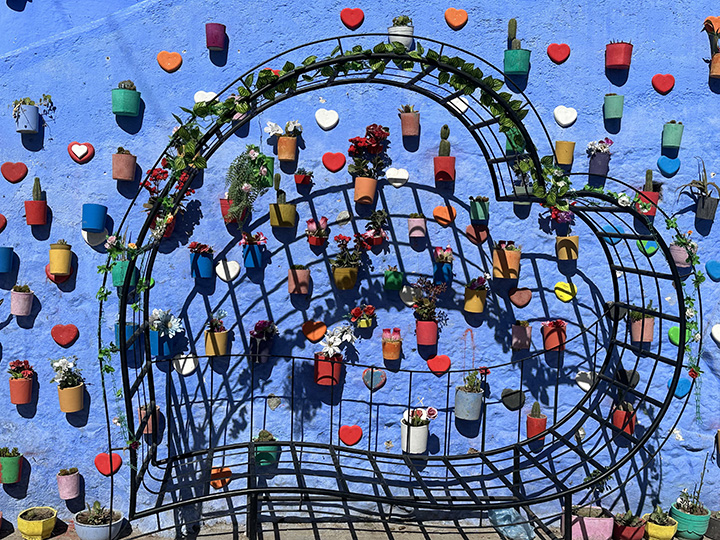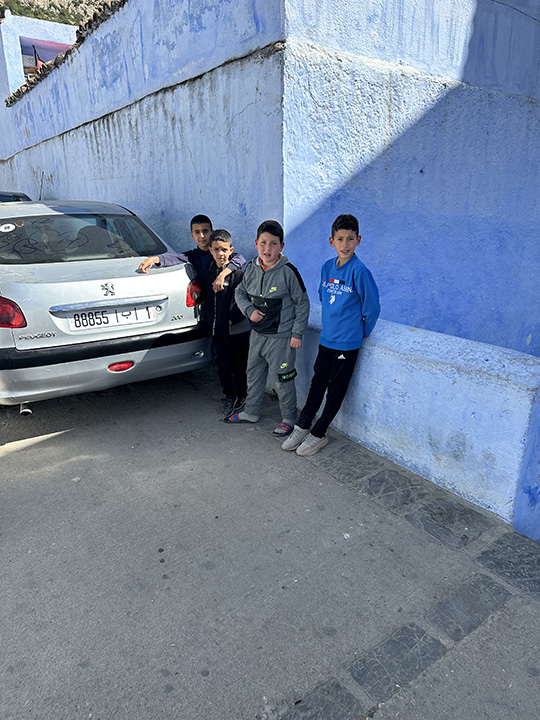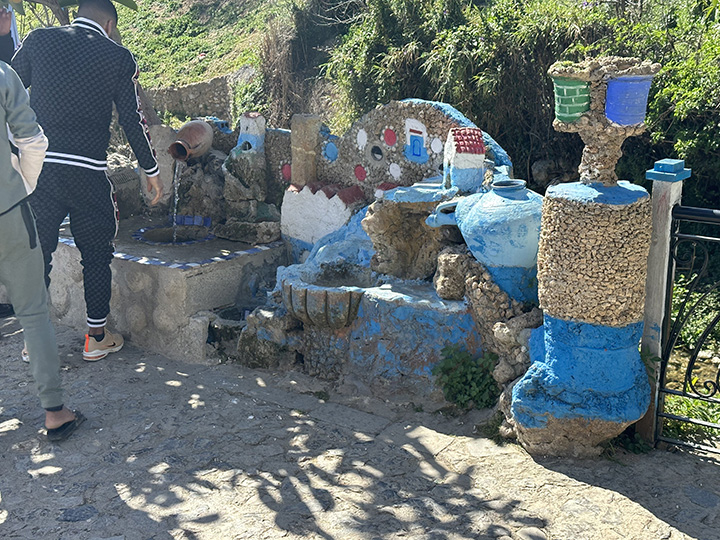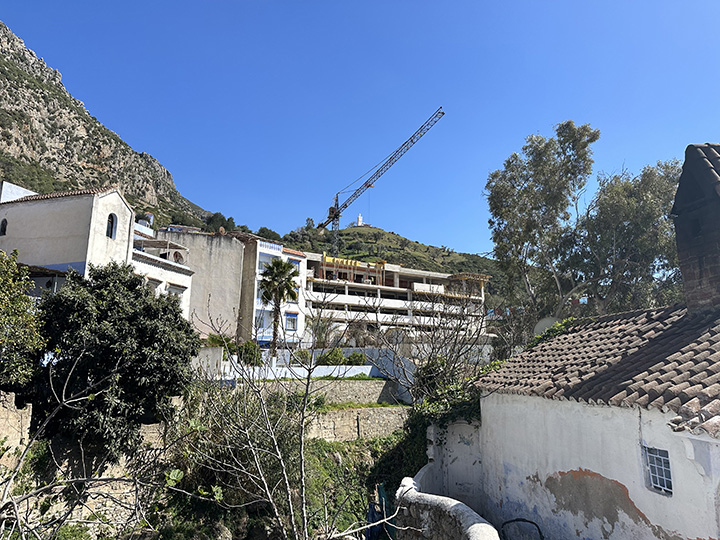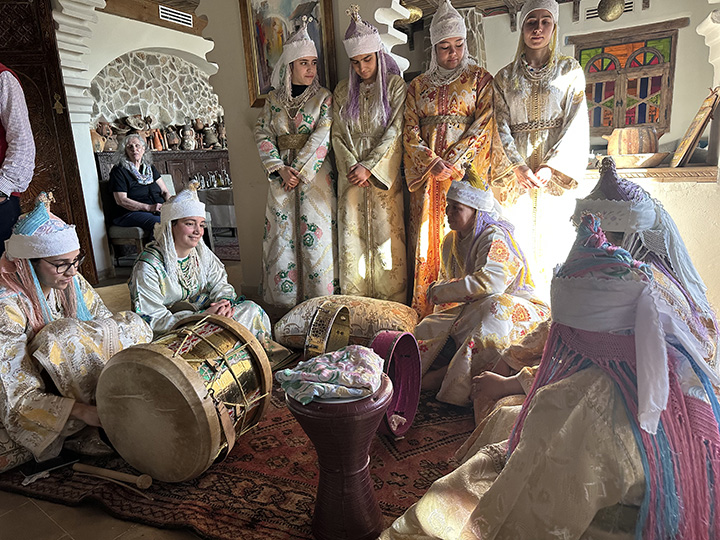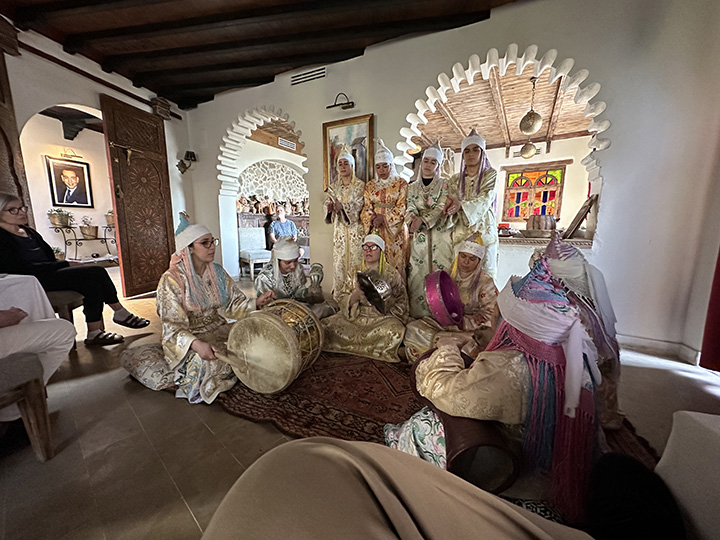|
Not only is the name of this place difficult to spell, itís not even easy to pronounce. Itís something like: shef-SHOW-in where show rhymes with how. We spent much of the day exploring its narrow, steep, winding streets, and then we enjoyed a performance by a Basra band.
Early morning in Chefchaouen from a hotel balcony.
Bill is poking around the hotel, trying to get a feel for this place. Chefchaouen will have a lot to offer besides too many vowels all in a row. Now let's go downstairs to the hotel courtyard where the Road Scholars are gathering to begin the day's touring.
"Ramadan Mubarak" is an Arabic greeting that means ďBlessed RamadanĒ. It is often used to wish someone well during the holy month of Ramadan. Ramadan is the ninth month of the Islamic lunar calendar. During this month, Muslims abstain from eating, drinking, smoking, and having sex from dawn to sunset. This includes taking medication. Today just happens to be the first day of Ramadan 2023. This will keep the rest of our trip interesting.
We will have a local guide today, giving Nabil a break.
Thatís Mustafa, our guideís assistant. He will bring up the rear making sure none of the Road Scholars escape the tour. Heís wearing a djellaba, just like the one I tried on the other day. He knows no English at all, but he's friendly and perfectly willing to communicate with hand-waving and pantomime.
As I understood it, that structure was built as a Christian chapel but now it's Spanish mosque. Some in our group hiked up there later in the day, but I didn't. They said the view of sunset up there was spectacular. Oh well.
Apparently we are going to follow our guide up that hill. I had no idea that this was going to be the easy part.
Pretty, right? We are about to walk those streets up and down the hill and up and down again and maybe even up and down again. My legs can probably tell you better than I can.
Guard rails? We donít need no stinkiní guard rails.
You certainly don't want to walk around here with your nose buried in your smartphone. One little misstep could break a leg.
Tim is being careful.
It's a pretty little town nestled against a mountain.
It was an attack by Portuguese forces under the command of King Afonso V that led to the founding of Chefchaouen in 1471. There was human habitation in the area before this, of course, but it was only after that the fortress of Chefchaouen began to thrive as a wider city, with Ghomaras (a group of northern Moroccan tribes), Moriscos (a group of Muslim descent) and Jewish people who had fled Spain and Portugal all settling in the area.
Those buildings by the stream were built for women to have a place to wash laundry. Hardly anybody uses them anymore because the tourists keep taking pictures of the women at work and they find that very annoying.
So now the tourists take pictures of the empty buildings.
Actually everything is pretty much empty today and will be until the end of Ramadan. Most people are indoors fasting, so we donít see the bustle of trade that we would normally see in this spot.
Just a tourist guide educating the infidels.
We keep going up.
There's a fruit vendor. Note the decorations on the wall.
Some say the walls are painted blue because the Jews who used to live here did it to remind them of the sky and God. Others say itís a reminder of the blue Mediterranean or blue keeps the houses cool or blue keeps mosquitoes away or maybe it just looks distinctive and nice. Another possibility is that all the blue paint attracts tourists. My guess is that has something to do with it.
Also, they say the reason the blue doesnít go all the way up the wall is because painting walls blue is womenís work and women canít reach that high. Hey, Iím just repeating what I was told.
But in most places the blue doesnít go all the way to the top.
And it is distinctive and it does look nice.
We passed lots of shops, some of which were even open on the first day of Ramadan.
Blue as high as women can reach.
We passed a fabric shop that was open.
We have stopped in front of one of five baking ovens in the city. People prepare their dough at home and bring it here to be baked.
But itís Ramadan, nobody is eating bread, and things are a little slow at the bakery today.
Thatís one of the other five bakeries and it has walls painted blue as high as the women can reach. Hey, I am just reporting what I was told.
Blue walls.
Everywhere you look.
But if you like, you can mix your paint with other colors. Those are dyes used to make the wash that colors the town.
People who donít have plumbing in their houses still use this well as a source of their water. I started to take a picture while a young woman was filling a bucket, but she was shy and waved me away. Or maybe she was just annoyed by this stupid tourist.
He's loving this.
The cat is less impressed.
The quintessential tourist.
I bet if I had wanted to buy anything he would have sold me something.
It really is a lovely and distinctive town.
Our guide took us inside an old Spanish building that housed the high school he once attended.
Thereís the school library.
Things are a little flatter in this part of town.
Let's have a look inside the local Kasbah.
The majestic Kasbah of Chefchaouen, which dates back to the 15th century, was built in 1471 by Rachid Ben Ali to protect the city and is located on the Outa El Hamman square, next to the great mosque. The Kasbah consists of a mosque, several dwellings and a wall that surrounds it, forming the centre of the city of Chefchaouen. The medina developed around the fortress, which has a square plan and is flanked by bastions and quadrangular towers. The main tower of the Kasbah is distinguished by its architectural structure and function. It has three floors, the last of which is a large covered terrace accessible through restored doors.
The interior garden is lovely.
There's even a fountain, but we're having a drought so as with many fountains we'll see on this trip...no water.
There are oranges, though. Nabil has told us that the kind of oranges that grow around here are no good for eating. You can, however, make marmalade with them, but Moroccans don't like marmalade. They do like orange blossoms, though. Moroccan orange blossoms are the fragrant flowers of the Citrus sinensis (orange tree). They are used in perfume making and have been written about as an aphrodisiac. They are traditionally associated with good fortune and joy, and have been popular in bridal bouquets and head wreaths for weddings. Moroccan orange blossom water is a perfumed distillation of bitter-orange blossoms. It is used as a flavoring in baked goods, and can refresh skin, help stimulate the circulation of lymphatic fluid to reduce puffiness, and nourish the hair. Well, that's what the internet says.
After all that walking, sitting around the Kasbah's central fountain was a welcome respite. Nabil used this time to answer all the questions weíd been saving up.
Time for a Road Scholar powwow.
Nabil used this time to answer all the questions weíd been saving up.
Nabil was doing his best, but the prayer was just a bit loud. Well, this is the first day of Ramadan after all.
Let's go find lunch.
Here we go...right inside that blue door.
The couscous with lamb and vegetables was delicious.
And for dessert we had homemade fig newtons.
Now there's an artfully decorated blue wall.
A closer look.
Nabil said that children safely roam free all over town as everybody knows them and takes care of them. It takes a village.
Blue art everywhere.
We are nearing our hotel at last. As I mentioned earlier, after dinner we have the option of walking up to that Spanish mosque on top of the mountain. No, just no.
But before dinner we enjoyed a performance by these young women who are members of a sect of Islam descended from Rabia Basri (714Ė801 CE), who was the first female Sufi saint of Islam. She was an Arab Muslim saint and Sufi mystic who lived as an influential religious figure. Rabia is generally credited as the founder of the Sufis. The name Sufi comes from a word meaning "wool". The Sufis reacted to the political turmoil of their times by retreating to an inner search for God. Rabia is regarded as a paradigm for Sufi women. .
These women are Sufi, like the whirling dervishes in Turkey, and they are known as the Feminine Hadra Band of Chefchaouen. Hadra is a collective ritual performed by Sufi orders. It is often held on Thursday evenings after the night prayer, on Fridays after jumu'ah prayer or on Sunday evenings, and can also be celebrated on special Islamic festivals and at rites of passage. As with other Sufi rituals like whirling dervishes, the music is intended to induce a hypnotic spiritual trance in listeners. The group performed poetry and music dating to the 12th to 15th century. Their costumes, or caftans, are traditional and belong to their mothers and grandmothers.
It was a very nice performance. Hypnotic, in fact.
|

